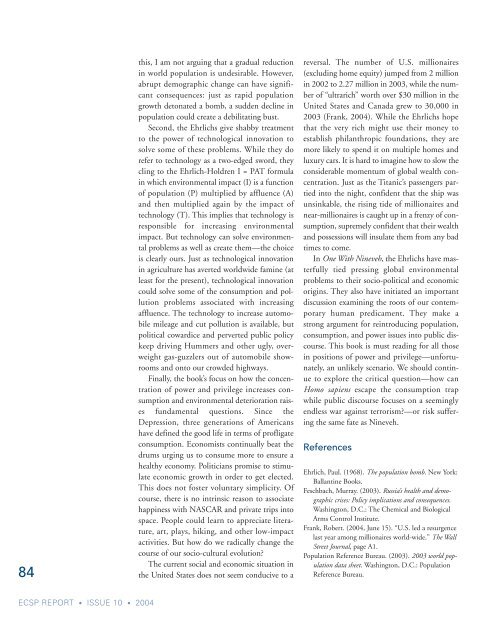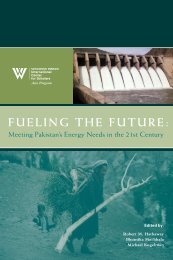Environmental Change and Security Project Report - Woodrow ...
Environmental Change and Security Project Report - Woodrow ...
Environmental Change and Security Project Report - Woodrow ...
You also want an ePaper? Increase the reach of your titles
YUMPU automatically turns print PDFs into web optimized ePapers that Google loves.
84<br />
this, I am not arguing that a gradual reduction<br />
in world population is undesirable. However,<br />
abrupt demographic change can have significant<br />
consequences: just as rapid population<br />
growth detonated a bomb, a sudden decline in<br />
population could create a debilitating bust.<br />
Second, the Ehrlichs give shabby treatment<br />
to the power of technological innovation to<br />
solve some of these problems. While they do<br />
refer to technology as a two-edged sword, they<br />
cling to the Ehrlich-Holdren I = PAT formula<br />
in which environmental impact (I) is a function<br />
of population (P) multiplied by affluence (A)<br />
<strong>and</strong> then multiplied again by the impact of<br />
technology (T). This implies that technology is<br />
responsible for increasing environmental<br />
impact. But technology can solve environmental<br />
problems as well as create them—the choice<br />
is clearly ours. Just as technological innovation<br />
in agriculture has averted worldwide famine (at<br />
least for the present), technological innovation<br />
could solve some of the consumption <strong>and</strong> pollution<br />
problems associated with increasing<br />
affluence. The technology to increase automobile<br />
mileage <strong>and</strong> cut pollution is available, but<br />
political cowardice <strong>and</strong> perverted public policy<br />
keep driving Hummers <strong>and</strong> other ugly, overweight<br />
gas-guzzlers out of automobile showrooms<br />
<strong>and</strong> onto our crowded highways.<br />
Finally, the book’s focus on how the concentration<br />
of power <strong>and</strong> privilege increases consumption<br />
<strong>and</strong> environmental deterioration raises<br />
fundamental questions. Since the<br />
Depression, three generations of Americans<br />
have defined the good life in terms of profligate<br />
consumption. Economists continually beat the<br />
drums urging us to consume more to ensure a<br />
healthy economy. Politicians promise to stimulate<br />
economic growth in order to get elected.<br />
This does not foster voluntary simplicity. Of<br />
course, there is no intrinsic reason to associate<br />
happiness with NASCAR <strong>and</strong> private trips into<br />
space. People could learn to appreciate literature,<br />
art, plays, hiking, <strong>and</strong> other low-impact<br />
activities. But how do we radically change the<br />
course of our socio-cultural evolution?<br />
The current social <strong>and</strong> economic situation in<br />
the United States does not seem conducive to a<br />
reversal. The number of U.S. millionaires<br />
(excluding home equity) jumped from 2 million<br />
in 2002 to 2.27 million in 2003, while the number<br />
of “ultrarich” worth over $30 million in the<br />
United States <strong>and</strong> Canada grew to 30,000 in<br />
2003 (Frank, 2004). While the Ehrlichs hope<br />
that the very rich might use their money to<br />
establish philanthropic foundations, they are<br />
more likely to spend it on multiple homes <strong>and</strong><br />
luxury cars. It is hard to imagine how to slow the<br />
considerable momentum of global wealth concentration.<br />
Just as the Titanic’s passengers partied<br />
into the night, confident that the ship was<br />
unsinkable, the rising tide of millionaires <strong>and</strong><br />
near-millionaires is caught up in a frenzy of consumption,<br />
supremely confident that their wealth<br />
<strong>and</strong> possessions will insulate them from any bad<br />
times to come.<br />
In One With Nineveh, the Ehrlichs have masterfully<br />
tied pressing global environmental<br />
problems to their socio-political <strong>and</strong> economic<br />
origins. They also have initiated an important<br />
discussion examining the roots of our contemporary<br />
human predicament. They make a<br />
strong argument for reintroducing population,<br />
consumption, <strong>and</strong> power issues into public discourse.<br />
This book is must reading for all those<br />
in positions of power <strong>and</strong> privilege—unfortunately,<br />
an unlikely scenario. We should continue<br />
to explore the critical question—how can<br />
Homo sapiens escape the consumption trap<br />
while public discourse focuses on a seemingly<br />
endless war against terrorism?—or risk suffering<br />
the same fate as Nineveh.<br />
References<br />
Ehrlich, Paul. (1968). The population bomb. New York:<br />
Ballantine Books.<br />
Feschbach, Murray. (2003). Russia’s health <strong>and</strong> demographic<br />
crises: Policy implications <strong>and</strong> consequences.<br />
Washington, D.C.: The Chemical <strong>and</strong> Biological<br />
Arms Control Institute.<br />
Frank, Robert. (2004, June 15). “U.S. led a resurgence<br />
last year among millionaires world-wide.” The Wall<br />
Street Journal, page A1.<br />
Population Reference Bureau. (2003). 2003 world population<br />
data sheet. Washington, D.C.: Population<br />
Reference Bureau.<br />
ECSP REPORT • ISSUE 10 • 2004

















